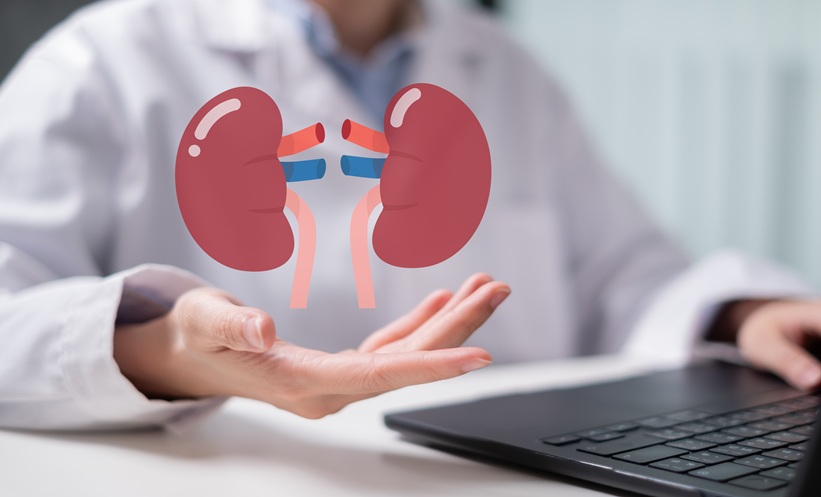Author: Laith Gergi, EMJ, London, UK
Citation: EMJ Nephrol. 2024;12[1]:24-28. https://doi.org/10.33590/emjnephrol/LDRC5958.
![]()
NEW CLINICAL TRIALS IN IgA NEPHROPATHY
IgAN is a progressive, immune complex-mediated disease, and the most common primary glomerulonephritis, representing the leading cause of chronic kidney and end-stage renal disease. The mechanism of IgAN involves the formation and deposition of circulating IgA-immune complexes in the glomeruli, triggering inflammation scarring, nephron loss, and ultimately kidney failure.
Johnathon Barratt, University of Leicester, UK, commenced the session by delivering a talk on the transformative progress of clinical trials for IgAN. For two-thirds of Barratt’s career, the clinical trial landscape for IgAN resembled a desolate desert, with patients relying on renin–angiotensin–aldosterone system inhibition (RAAS-i) and lifestyle modifications, inevitably destined for dialysis. However, over the past decade, this stagnation has given way to an explosion in new clinical trial activities. Barratt attributes this shift to several critical factors, including regulatory changes, enhanced understanding of disease pathogenesis, and evolving clinical guidelines.
REGULATORY CHANGES AND CLINICAL GUIDELINES
Drug development in IgAN had been largely static for decades due to the lack of validated measurements for clinical outcomes in large-scale, long-term clinical trials. A pivotal moment in IgAN research was the publication of a study that established proteinuria reduction as a surrogate endpoint for clinical endpoints in IgAN.1 This triggered a re-evaluation by drug regulators of how drug efficacy is assessed in rare kidney diseases. Barratt highlighted the collaboration between academic nephrologists and industry partners, exemplified by the Kidney Health Initiative: a partnership between the American Society of Nephrology (ASN) and the U.S Food and Drug Administration (FDA). The Kidney Health Initiative endorsed the use of early proteinuria changes, observable around 9 months, as a recognisable and provable endpoint for primary glomerular diseases, a criterion now accepted in both the USA and Europe.
This regulatory framework has reshaped clinical trials, enabling the pharmaceutical industry to invest in IgAN treatments confidently. Trials now typically involve 400 patients, assessing drug efficacy by monitoring proteinuria at 9 months, and tracking glomerular filtration rate changes over 2 years. This design ensures timely and cost-effective development of new drugs.
ENHANCED UNDERSTANDING OF IgA NEPHROPATHY PATHOGENESIS
The surge in clinical trials also stems from a deeper understanding of the pathogenesis of IgAN. Advances in identifying the formation of pathogenic immune complexes, abnormalities in the IgA molecule, and genetic risk loci have illuminated new therapeutic targets. Barratt emphasised the role of genome-wide association studies in uncovering genetic risk alleles, many of which correspond to druggable pathways.
This refined knowledge has driven the development of targeted therapies. Barratt discussed traditional strategies for treating immune-related kidney diseases, including B-cell depletion and modulation. Rituximab has historically been shown to be effective but new therapies targeting CD38, a cell surface protein expressed on plasma cells, therapies such as felzartamab and mezagitamab, are in advanced trial phases. A greater understanding of pathogenic IgA led to the finding that IgA is likely derived from the mucosal immune system, and not plasma cells and B cells in the bone marrow or central lymphoid sites. This led to the development of the NEFIGAN trial, in which budesonide was found to specifically target IgA production in the gut, and demonstrated efficacy in reducing pathogenic IgA and preserving kidney function. However, it requires repeated treatment to maintain benefits.
GLOMERULAR INFLAMMATION AND CHRONIC KIDNEY DISEASE CONSEQUENCES
Barratt detailed the strategies for mitigating glomerular inflammation, a key factor in IgAN progression. While systemic glucocorticosteroids are effective anti-inflammatories, their significant side effects limit their long-term use. Complement inhibition has emerged as a promising alternative. Trials targeting components of the complement system, such as factor B, D, and C5, have shown potential in reducing proteinuria and inflammation, with drugs like ravulizumab demonstrating significant efficacy.
The average glomerular filtration rate when IgAN diagnosis is made is between 50–60 mL/min, which informs nephrologists that close to half of a patient’s nephrons have been lost. Therefore, when treating IgAN, it is crucial to address maladaptive downstream responses of nephron loss, such as systemic hypertension, glomerular hyperfiltration, and proteinuria, which can contribute to segmental scarring. Managing the downstream consequences of IgAN, particularly in chronic kidney disease, has seen advancements. New therapies, including sodium-glucose cotransporter 2 inhibitors and endothelin receptor antagonists, have shown effectiveness in preserving kidney function. The PROTECT trial, for example, demonstrated that sparsentan, an oral dual endothelin angiotensin II receptor antagonist, significantly slows kidney function decline.2 Sparsentan received accelerated approval from the FDA in 2023 for proteinuria reduction in high-risk patients with IgAN, with continued approval hinging on sparsentan delaying long-term kidney function decline.
FUTURE PROSPECTS
Barratt stated that the future of IgAN treatment looks promising, with several new therapies receiving regulatory approval. Nefecon, sparsentan, and sodium-glucose cotransporter 2 inhibitors have been approved by the European Medicines Agency (EMA), with more treatments likely to follow. The global nephrology community’s concerted effort in recruiting patients from every continent for IgAN trials has been instrumental in this progress, with Europe playing a particularly crucial role. As Barratt aptly concluded, the era of passive management of IgAN is over, heralding a new dawn of proactive and innovative treatment strategies.
UNDERSTANDING THE MEMBRANOUS NEPHROPATHY DISEASE MECHANISMS
Nicola M. Tomas, University Medical Center Hamburg-Eppendorf, Germany, provided an in-depth exploration of the pathogenesis and emerging treatments for membranous nephropathy (MN). Tomas’ talk emphasised both the complex role of the complement system in MN, and the promising strides in plasma cell-targeted therapies.
MN is an antibody-mediated autoimmune disease, characterised by the thickening of the glomerular filtration barrier and the deposition of IgG and complement components like C3. Tomas detailed how these histological features, observable through both light and electron microscopy, indicate that podocytes are the primary targets in the disease. MN represents the most common cause of nephrotic syndrome; in most patients, there is no identified underlying cause of MN. Immunofluorescence has detected the granular deposition of IgG autoantibodies and complement components, such as the membrane attack complex, demonstrating that the antibody and complement system play a role in MN pathogenesis.3 The identification of phospholipase A2 receptor 1 (PLA2R) as a target antigen in 2009 marked a breakthrough, followed by the discovery of other antigens implicated in MN.4 Antibodies targeting thrombospondin Type 1 domain-containing 7A and PLA2R podocyte antigens account for 75% of MN cases.3 For these patients, it is known that the autoantibodies are directly pathogenic; binding to podocytes, inducing complement, triggering disturbance of podocyte structure, and leading to proteinuria.
Therefore, the logical progression is the therapeutic target of the complement system as the final effector mechanism contributing to podocyte damage and target of plasma cells, to reduce autoantibody production. However, to date there are no randomised clinical trials for complement in MN, but that is not the end of the story.
THE ROLE OF THE COMPLEMENT IN MEMBRANOUS NEPHROPATHY
Tomas explained the involvement of the complement system in MN, which is a cascade activated via three pathways (alternative, classical, and lectin). Renal biopsies from patients with MN identified components from all three complement pathways, demonstrating the significance of complement in disease progression. Research at University Medical Center Hamburg revealed strong C1Q deposition in patients from proximity ligation assays, pointing to the classical pathway’s significant role.3 Tomas acknowledged that this was surprising, given that most antibodies against PLA2R1 and thrombospondin Type 1 domain-containing 7A are of the IgG4 subclass, which does not activate the classical pathway. However, the presence of IgG1, IgG2, and IgG3 subclasses, which can bind C1Q, was found in patients, indicating a complex interplay in complement activation.3
B-CELL AND PLASMA CELL TARGETING
Tomas also covered the critical role of B-cells and plasma cells in MN. Plasmablasts and plasma cells are the main source of antibodies, and are typically negative for the cell surface marker CD20, which is currently the focus of B-cell targeted treatments on the market. Tomas reviewed several key clinical trials, including the GEMRITUX and MENTOR trials, which demonstrated the efficacy of rituximab in achieving significant remission rates compared to supportive care and cyclosporine + glucocorticosteroids.5,6 Despite these advances, 20–40% of patients remain refractory to B-cell targeting, possibly due to the persistence of long-lived plasma cells in the bone marrow escaping treatment, and persisting as drivers of autoimmunity by producing PLA2R autoantibodies. Hence, a potential solution according to Tomas may be the targeting of plasma cells.
Currently the only plasma cell targeting therapy to have preliminary clinical trial data is an anti-CD38 monoclonal antibody, called felzartamab. Data from the Phase 1b/2a M-PLACE felzartamab clinical trial was presented at ASN Kidney Week 2023.7 Two cohorts of patients received nine infusions over 5 months, with an observation period of 12 months. The first cohort was composed of newly diagnosed or relapsed patients, while the second cohort included refractory patients. Early and significant reductions in anti-PLA2R antibodies were observed with 74% of patients, experiencing >50% decrease in anti-PLA2R antibodies.7 Clinically, 47% of patients in cohort one, and 18% of patients in cohort two achieved partial remission. However, there were no complete remissions reported in the study, which Tomas noted may be due to the relatively short observation period.7 Tomas stressed that the data are promising and demonstrate the potential of plasma cell-targeted therapies.
Tomas concluded by explaining that, although there is mechanistic evidence for a pathogenic role of the complement system in MN, clinical trials seem to be failing. The only complement-targeted clinical trials (RENEW and ‘iptacopan versus rituximab’) have been terminated, and the narsoplimab anti-mannan-binding lectin-associated serine protease-2 antibody trial has an unknown status.8,9,10 However, indirect depletion of antibody-secreting cells has become the mainstay of treatment in membranous nephropathy, though formally off-label in most parts of the world. Moreover, the initiation of the NewPLACE and MONET trials on felzartamab means we may expect data on plasma cell-targeted therapies in the near future.
CONCLUSION
The talks by Barratt and Tomas highlighted a promising future for glomerulonephritis treatment. Advancements in IgAN and MN clinical trials, particularly in targeted therapies and regulatory frameworks, herald a new era of effective disease management, offering improved outcomes for patients previously left with few treatment options.






